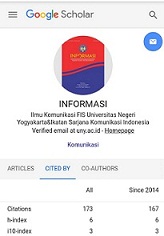Terbentuknya Identitas Fans Sepak Bola sebagai Budaya Massa dalam Industri Media
DOI:
https://doi.org/10.21831/informasi.v46i2.11377Keywords:
Football, Fans, IdentityAbstract
References
Anderson, Benedict (1999). Komunitas-komunitas Imajiner, Asal-usul dan Penyebaran Nasionalisme (Terj). Yogyakarta : Pustaka Pelajar.
Barker, Chris (2005). Cultural Studies, Teori dan Praktek. (Terj). Yogyakarta : Bentang Pustaka.
Charon, John M. (2007). Symbolic Interactionism: An Introduction, An Interpretation, An Integration. New Jersey: Pearson Prentice Hall.
Coakley, Jay (2001). Sport in Society: Issues and Controversies. London : McGraw-Hill.
Fiske, Jhon (1987). Television Culture London : Routledge.
Hogg, Michael A, dan Terry J. Deborah (ed) (2001). Social Identity Processes in Organizational Contexts. Philadelphia: Psychology Press.
Jacobson, Beth (2003). The Social Psychology of the Creation of a Sports Fan Identity: A Theoretical Review of The Literature. Athletic Insight, Volume 5, Issue 2, Juni 2003.
Marcia, James E (1993). Ego Identity, A Handbook for Psychosocial Research. New York : Springer Verlag.
Martin, Judith N. dan Thomas K. Nakayama (2004). Intercultural Communication in Context. Boston: McGraw-Hill.
Munro, Clayton Edward Steven (2006). Sports Fan Culture & Brand Community: An Ethnographic Case Study of The Vancouver Canucks Booster Club. Faculty of Graduate Studies (Human Kinetics). University of British Columbia.
Samovar, Larry A., Richard E. Porter, Edwin R. McDaniel. (2010) Communication Between Cultures. Boston : Cangage Learning
Storey, John, (2007). Cultural Studies dan Kajian Budaya Pop (Terj). Yogyakarta: Jalasutra.
Tomlinson, J (1999). Globalization and Culture. Cambridge, UK: Polity Press.
Valdivia, Angharad N [ed] (2006). A Comparison to Media Studies. USA : Blackwell Publishing.
Downloads
Published
How to Cite
Issue
Section
Citation Check
License
Authors who publish with this journal agree to the following terms:
- Authors retain copyright and grant the journal right of first publication with the work simultaneously licensed under a Creative Commons Attribution License that allows others to share the work with an acknowledgement of the work's authorship and initial publication in this journal.
- Authors are able to enter into separate, additional contractual arrangements for the non-exclusive distribution of the journal's published version of the work (e.g., post it to an institutional repository or publish it in a book), with an acknowledgement of its initial publication in this journal.
- Authors are permitted and encouraged to post their work online (e.g., in institutional repositories or on their website) prior to and during the submission process, as it can lead to productive exchanges, as well as earlier and greater citation of published work (See The Effect of Open Access).












